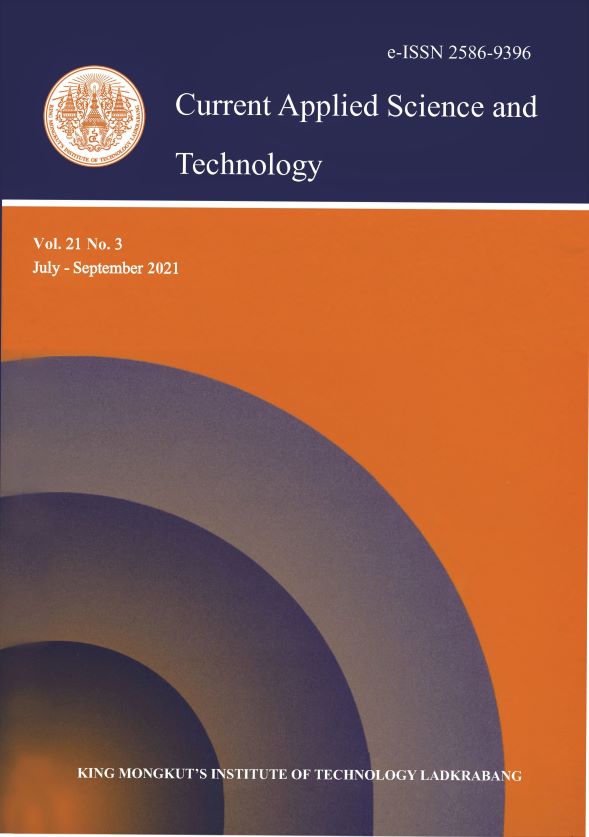Energy Efficiency Improvement in Micro-sized Food Processing Enterprises via Automatic Cooking Gas Control
Main Article Content
Abstract
Food processing is a big industry in many countries. The industry consumes large amount of energy, primarily from liquefied petroleum gas (LPG). Food frying is conventionally controlled via the cooking oil temperature, which is regulated by controlling the amount of heat provided by the cooking gas burner, hence, consumption rate of LPG. For micro-sized food processing enterprises in Thailand, this is usually done manually by operators, resulting in poor energy efficiency and non-negligible amount of waste. To prevent such situations, it is necessary to control the food cooking process more precisely. The objective of this work was to develop a precise control system for a gas cooking stove used to fry rice crackers with an improved energy efficiency and fuel economy. This work reports on the development and testing of an automatic burner control system for an LPG cooking stove used to provide heat in frying Thai rice crackers. The system was based on low-cost sensing of the frying oil temperature and two-step control of gas valves. It was found that the automatic control system employed worked well and more precise control of the frying oil temperature could be achieved. Results of the experimental testing with and without automatic control of the LPG cooking stove in the laboratory setup indicated that better food processing control could give rise to almost 40% improvement in fuel economy for processing rice crackers.
Keywords: energy saving; process control; semi-automation; food engineering; LPG
*Corresponding author: E-mail: n.tippayawong@yahoo.com
Article Details
Copyright Transfer Statement
The copyright of this article is transferred to Current Applied Science and Technology journal with effect if and when the article is accepted for publication. The copyright transfer covers the exclusive right to reproduce and distribute the article, including reprints, translations, photographic reproductions, electronic form (offline, online) or any other reproductions of similar nature.
The author warrants that this contribution is original and that he/she has full power to make this grant. The author signs for and accepts responsibility for releasing this material on behalf of any and all co-authors.
Here is the link for download: Copyright transfer form.pdf
References
Office of Agricultural Economics, 2019. Agricultural Economic Information. [online] Available at: www.oae.go.th/view/1/Information
Federation of Thai Industries, 2020. Knowledge Management. [online] Available at: www.fti.or.th
National Food Institute, 2020. Food Intelligence Center Thailand. [online] Available at: www.nfi.or.th
Ladha-Sabur A., Bakalis, S., Fryer, P.J. and Lopez-Quiroga, E., 2019. Mapping energy consumption in food manufacturing. Trends in Food Science & Technology, 86, 270-280.
Jagtap, S., Rahimifard, S. and Duong, L.N.K., 2019. Real-time data collection to improve energy efficiency: a case stury of food manufacturer. Journal of Food Processing and Preservation, 2019, https://doi.org/10.1111/jfpp.14338
Clairand, J., Briceno-Leon, M., Escriva-Escriva, G. and Pantaleo, A.M., 2020. Review of energy efficiency technologies in the food industry: trends, barriers, and opportunities. IEEE Access, 8, 48015-48029.
Suwansri, S., Moran, J.C., Aggarangsi, P., Tippayawong, N., Bunkham, A. and Rerkkriangkrai, P., 2014. A biomethane solution to domestic cooking in Thailand. Energy for Sustainable Development, 23, 68-77.
Grieshop, A.P., Marshall, J.D. and Kandlika, M., 2011. Health and climate benefits of cookstove replacement options. Energy Policy, 12(12), 7530-7542.
Energy Policy and Planning Office -Ministry of Energy, 2020. Annual Energy Statistics 2018. [online] Available at: www.eppo.go.th
Jugjai, S., Tia, S. and Trewetasksorn, W. 2001. Thermal efficiency improvement of an LPG gas cooker by a swirling central flame. International Journal of Energy Research, 25, 657-674.
Das, T., Subramanian, R., Chakkaravarthi, A., Singh, V., Ali, S.Z. and Bordoloi, P.K., 2006. Energy conservation in domestoc rice cooking. Journal of Food Engineering, 75(2), 156-166.
Suwansri, S., Moran, J.C., Aggarangsi, P., Tippayawong, N., Bunkham, A. and Rerkkriangkrai, P., 2015. Converting LPG stoves to use biomethane. Distributed Generation and Alternative Energy Journal, 30(1), 38-57.
Shinede, Y.H., Gudekar, A.S., Chavan, P.V., Pandit, A.B. and Joshi, J.B., 2016. Design and development of energy efficient continuous cooking system. Journal of Food Engineering, 168, 231-239.
Ogedengbe, E.O.B. and Ajibade, F.D., 2017. Improved burner efficiency and fuel consumption in domestic cooking appliances. Energy and Policy Research, 4(1), 29-35.
Kaushik, L.K., Deb, S. and Muthukumar, P., 2018. Energy saving and techno-economic assessment of self aspirated domestic LPG stove with porous radiant burner. IOP Conference Series: Materials Science and Engineering, 377, 012194, https://doi.org/10.1088/1757-899X/ 377/1/012194
Mishra, N.K. and Muthukumar, P., 2018. Development and testing of energy efficient and environment friendly porous radiant burner operating on liquefied petroleum gas. Applied Thermal Engineering, 129, 482-489.
Oke, E.K., Idowu, M.A., Sobukola, O.P., Adeyeye, S.A.O. and Akinsola, A.O., 2018. Frying of food: a critical review. Journal of Culinary Science and Technology, 16(2), 107-127.
Lewis, F.L., Varabie, D.L. and Syrmos, V.L., 2012. Optimal Control. 3rd ed. Singapore: Wiley.


